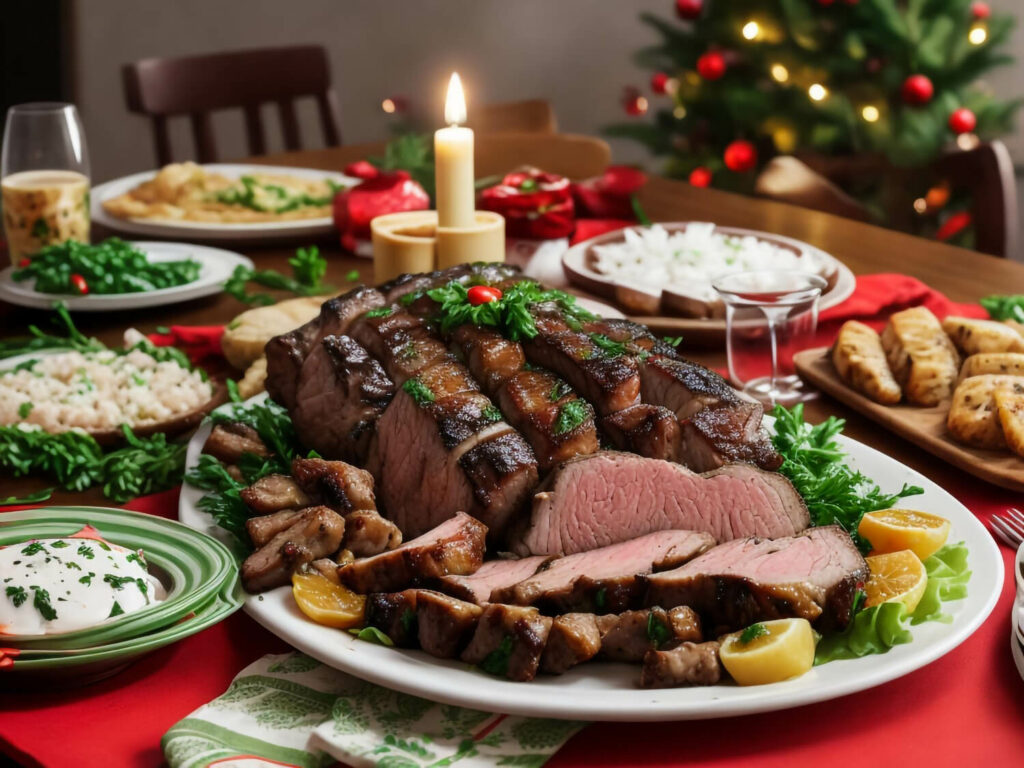Tender, juicy, bursting with flavor – the holy grail of any barbecue lover. But achieving the melt-in-your-mouth brisket requires patience and understanding.
The biggest question, however, often hangs heavy in the air: How long to smoke brisket to such juicy perfection? We will answer this question, and give you some tips on how to marinate the brisket, what smoker to use, and much more, so stay till the end to find out our secret.
Factors that Affect the Texture and Flavor of Brisket
Several factors influence how long does it take to smoke a brisket, including its final texture, and flavor. These are some of the most important factors:
Brisket Selection
- Marbling: the intramuscular fat within the brisket. More marbling translates to richer flavor and a more tender texture as the fat melts during cooking, basting the meat and keeping it moist.
- Cut: Brisket comes in two main cuts: the point and the flat. The point has a higher fat content and generally results in a more flavorful and tender outcome, while the flat, though leaner, can still achieve good texture with proper cooking techniques.
Cooking Technique
- Smoking Time and Temperature: Low and slow is the name of the game for brisket. Extended cooking times at temperatures between 225-250°F allow the tough connective tissues to break down, resulting in that melt-in-your-mouth tenderness. Read till the end to find out how long to smoke a brisket at 225°F.
- Wrapping: Wrapping the brisket in foil during the stall can help retain moisture and accelerate the cooking process, leading to a juicier and more tender outcome.
Resting
- The Final Touch: After the long cooking, allowing the brisket to rest for a sufficient amount of time is crucial. This allows the juices to redistribute throughout the meat, ensuring maximum tenderness and flavor in each bite.
How to Choose the Best Brisket for Smoking?
Picking the perfect brisket is the foundation for smoking success. Here’s what to look for:
- Size matters. Bigger briskets (generally 10 pounds and above) are ideal for smoking. They offer more meat and allow for longer cooking times, which are crucial for achieving that melt-in-your-mouth tenderness.
- Marbling. Look for a brisket with generous marbling throughout the muscle. These white flecks of fat are your friends, adding flavor and moisture while cooking. Avoid briskets with minimal marbling, as they tend to dry out easily.
- Fat cap check. The fat cap on the brisket plays a vital role. Opt for a white, clean fat cap, indicating a grain-fed cow. Yellowish fat often indicates grass-fed cows, which may not render as well during smoking.
- Color clues. The meat color should be a consistent, deep reddish pink. Avoid briskets with overly dark or pale colors, as these could signal improper handling or aging.
- Flexibility test. Give the brisket a gentle bend. It should have some give, indicating good muscle quality and promising tenderness after cooking. Rigid briskets might be tougher and less enjoyable.

How to Marinate the Brisket
Marinating isn’t strictly necessary for a delicious smoked brisket, but it can certainly enhance the flavor and tenderness. Here’s how to approach it:
- Flavorful infusion: Marinades typically consist of a combination of acidic ingredients (vinegar, citrus juice, wine), oils (olive oil, Worcestershire sauce), herbs and spices, and sometimes sweeteners (brown sugar, honey). These elements work together to infuse the brisket with flavor and potentially tenderize the meat.
- Timing: Marinating times vary depending on the recipe and desired level of flavor penetration. Generally, 8-12 hours is a good starting point for a brisket. However, marinating for longer periods (up to 24 hours) won’t hurt, as the natural marbling in the brisket helps prevent over-absorption of the marinade.
- Important note: Don’t reuse the marinade directly after removing the brisket. It might contain harmful bacteria from the raw meat. You can boil the marinade for a few minutes to kill bacteria and use it as a basting sauce during smoking.
- Flavor: While marinades primarily add flavor, some ingredients, like acids, can slightly break down the tough muscle fibers in the brisket, potentially contributing to increased tenderness. However, the primary tenderization factor for brisket remains the low and slow cooking process during smoking.
Electric, charcoal, or wood smoker – which one’s your pick?
Choosing between an electric, charcoal, or wood smoker comes down to personal preference and priorities. Here’s a breakdown of these smokers:
Electric Smokers
- Convenience: Electric smokers are the ultimate “set it and forget it” option. Plug it in, set the temperature, and let the smoker do its magic. This makes them ideal for beginners or those who value ease of use.
- Consistent control: Electric smokers maintain a very stable temperature, minimizing the need for constant monitoring. This can be helpful for achieving consistent results.
- Limited smoke flavor: While electric smokers produce delicious food, they often lack the intense, complex smoke flavor achieved with charcoal or wood smokers.
Charcoal Smokers
- Flavor champion: Charcoal smokers deliver the most robust, classic smoke flavor, thanks to the direct combustion of fuel. This is a major draw for purists and those seeking a truly smoky experience.
- Hands-on experience: Using a charcoal smoker requires more attention and skill to manage the fire and maintain consistent temperatures. This hands-on approach can be part of the enjoyment for some.
- Temperature fluctuations: Charcoal smokers naturally experience temperature fluctuations, which can require adjustments throughout the smoking process.
Wood Smokers
- Wood-fired flavor: Similar to charcoal smokers, wood smokers offer a distinct, wood-infused smoke flavor that electric smokers can’t quite replicate. This is ideal for those who want the full “smokehouse” experience.
- Fuel flexibility: Wood smokers offer the most fuel versatility, allowing you to experiment with different types of wood chips or chunks for unique flavor profiles.
- Requires expertise: Like charcoal smokers, wood smokers demand a higher level of expertise to manage the fire and maintain temperature control.
Ultimately, the “best” smoker depends on your individual preferences. If convenience is your priority, an electric smoker might be ideal. If you crave the classic smoky flavor and enjoy the hands-on experience, a charcoal or wood smoker might be a better fit.
How Long to Smoke Brisket?
Smoking a brisket is a low and slow process, so patience is important. While there’s no single definitive answer to how long does it take to smoke a brisket, here’s a breakdown to help you estimate:
General Rule of Thumb: A good starting point is to plan for 1-1.5 hours of smoking time per pound of brisket. So, a 10-pound brisket might take around 10-15 hours, while a 15-pounder could take 15-22.5 hours.
Factors Affecting Cooking Time
- Smoker Type: Electric smokers tend to cook slightly faster than charcoal or wood smokers due to more stable temperature control.
- Cooking Temperature: Higher temperatures generally lead to faster cooking times, but also increase the risk of dryness. Aim for a range of 225-250°F for optimal results.
- Internal Temperature: Forget about time and focus on the internal temperature of the brisket. It’s done when it reaches 195-205°F for that melt-in-your-mouth tenderness.
- The Stall: Brisket often experiences a “stall” where the internal temperature plateaus for a while. Don’t panic! This is normal and doesn’t affect the final outcome. Just keep smoking until the internal temperature reaches the desired range.
Remember: These are just estimates. It’s always best to use a reliable internal thermometer to gauge doneness accurately.
Resting the Brisket – The Key to Juiciness
After the long smoking process, you need to stay patient. Resting the brisket is crucial for achieving the ultimate tenderness and juiciness.

During cooking, the muscle fibers contract, pushing moisture towards the surface. Resting allows these fibers to relax and redistribute those juices throughout the meat, resulting in a more even and delicious experience.
How Long to Rest?
Aim for at least 1-2 hours of resting time. Ideally, shoot for 2-3 hours for optimal results. This allows ample time for the juices to redistribute and the internal temperature to stabilize.
Resting Methods
There are two main methods for resting brisket:
- Unwrapped: Place the brisket on a cutting board at room temperature. This is ideal if you plan on serving it immediately.
- Wrapped: Wrap the brisket tightly in butcher paper or aluminum foil. This method is helpful for holding the brisket warm for a few hours before serving or storing it for later.
Remember, even while resting, the brisket will continue to cook slightly due to carryover heat. This is perfectly normal and won’t affect the final tenderness.
Serving and Slicing
Once the resting period is complete, it’s time to slice and serve your masterpiece. Brisket is typically sliced against the grain, which helps break down the muscle fibers and further enhance tenderness.
Use a sharp knife and slice the brisket into thin pieces, ready to be enjoyed on its own, on buns, or alongside your favorite barbecue sides.
Check out more of our recipes here.




